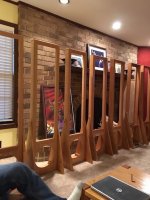Hi
I have recently purchased 250 loudspeaker units, 4" and 6", but don´t know that much about them yet.
Are there any mildly crazy ways to use them for something fun?
I am thinking about a wall of sound, but the wife doesn´t like the idea.
I have recently purchased 250 loudspeaker units, 4" and 6", but don´t know that much about them yet.
Are there any mildly crazy ways to use them for something fun?
I am thinking about a wall of sound, but the wife doesn´t like the idea.
I have a bunch of ESL panels and wonder the same.
With just two channels, you can blend L and R across a large wall rather than have all the L on the left and R on the right.
Of course, with just an excellent pair of L and R speakers, the virtual middle can be quite well formed, as revealed when tested on a dual-mono signal.
With just two channels, you can blend L and R across a large wall rather than have all the L on the left and R on the right.
Of course, with just an excellent pair of L and R speakers, the virtual middle can be quite well formed, as revealed when tested on a dual-mono signal.
Assuming the 4 inch drivers can play reasonably full range, the line source idea seems interesting.
Even in stereo, you could do some things that wouldn't have to cover a whole wall (if that's what your wife is bothered by), but would still need a lot of drivers.
In enclosures with separate amps for front and back arrays (and some signal processing), you could do a speaker that's switchable between monopole, dipole, bipole, and cardioid. If you're looking for a project that has lots of tuning options, that should do it.
Even in stereo, you could do some things that wouldn't have to cover a whole wall (if that's what your wife is bothered by), but would still need a lot of drivers.
In enclosures with separate amps for front and back arrays (and some signal processing), you could do a speaker that's switchable between monopole, dipole, bipole, and cardioid. If you're looking for a project that has lots of tuning options, that should do it.
Last year I bought a couple of cases of approx 4" speaker for cheap. Never did build a line array. It will be fun to see what you build. We would love to see photos.
Hi
I have recently purchased 250 loudspeaker units, 4" and 6", but don´t know that much about them yet.
Are there any mildly crazy ways to use them for something fun?
I am thinking about a wall of sound, but the wife doesn´t like the idea.
I would go for the wall of sound and hide the wife behind it !
What kind of cells do you have?
Got a large carton of them from Mike Wright of Dayton-Wright fame. Likely XG-8. Plastic in-depth frames (look like egg-crate luminaire "lenses").
I have a bunch of ESL panels...
And I have a bunch of ESL frames with no panels!
Attachments
Are there any good sources for designing "wall of sound" or planar(?) arrays?
I don't know of any design guides for multiple arrays but my website is an extensive guide for building hybrid ESL's.
And I'm not building a "wall of sound", BTW. The four pairs of speaker frames shown in the photo will be wire-stator ESL's for my audio buddies at Carver-fest who've begged me for years to do this. It's a huge project which Ive been working on for months, and way more work than I would ever commit to again.
Attachments
Last edited:
Build an XG-16. Just add nitrogen.... from Mike Wright of Dayton-Wright fame. Likely XG-8.
Are there any good sources for designing "wall of sound" or planar(?) arrays?
Planar arrays suffer from a form of destructive interference called comb filtering. They enjoyed brief popularity in the 1960s mostly thanks to a popular electronics article called "the sweet sixteen speaker system", in the January 1961 issue.
I built a pair of sweet sixteens against all good judgement, just to see what the fuss was all about, and they are quite interesting but do not live up to the claims made for them.
A bessel array uses lots of drivers, but feeds some of them with reversed polarity to counteract the effects of comb filtering and improve polar response. It could have some merit, but I foresee a lot of effort for mediocre result. If you search bessel array you will likely find some useful info.
Line arrays are probably your best bet, but unfortunately they are quite ugly, and large, and it would probably be asking a lot of your spouse to share space with them.
Do you have any photos of the drivers? I'm curious what you bought.
A bessel array uses lots of drivers, but feeds some of them with reversed polarity to counteract the effects of comb filtering and improve polar response. It could have some merit, but I foresee a lot of effort for mediocre result. If you search bessel array you will likely find some useful info.
Here's a good idea of what Bessel array's look like.
A Paul Kemble web page - speaker bessel arrays.
- Home
- Loudspeakers
- Planars & Exotics
- too many loudspeaker units

